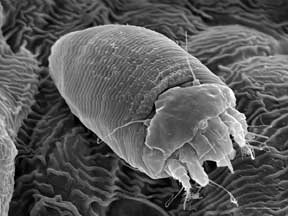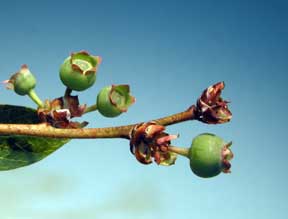Post-harvest is the optimal time for blueberry bud mite control
Editor’s note: This article is from the archives of the MSU Crop Advisory Team Alerts. Check the label of any pesticide referenced to ensure your use is included.
Over the past five years, blueberry bud mite (Acalitus vaccinii) has been identified as the cause of some problems with poor growth and low yield in Michigan blueberry fields. Sampling by grower groups, extension educators and the small fruit entomology program detected this pest across most of the major blueberry production regions in our state. However, only some fields have sufficient populations to cause economic levels of injury, and only some cultivars are susceptible. For example, in Grand Junction we have seen ‘Rubel’ bushes with high infestation and damaged growth growing next to ‘Bluecrop’ plants that showed no visible symptoms. Because of this, bud mite management is warranted only in fields where 1) poor growth and damage have been seen, and 2) high bud mite populations have been verified by magnified analysis of bud samples.
This mite is microscopic (Photo 1), and feeds inside buds in the winter, causing damage to developing tissues and resulting in symptoms that include blistered red bud scales in spring, misshapen flowers, small leaves and fruit, or few berries per cluster (Photo 2). The wide variability in symptoms among varieties adds to the difficulty in diagnosing this pest injury. Berries on infected shoots may also appear roughened and malformed. While these symptoms may be indicators of infestation, it is best to take shoot samples in the late fall or early spring to identify infestations. Bud mites are moving to fruit buds formed this year to find places to spend the winter, so sampling should include the top six inches of shoots with fruit buds. These should be examined to verify that bud mites are the problem, because some of the symptoms are quite similar to the catch-all category of winter damage. This can be done with a hand lens if you know what to look for, or can be done under a microscope by trained personnel. Send samples to your local extension office, to your crop consultant, or to MSU Diagnostic Services (www.pestid.msu.edu) for checking.

Photo 1. Microscopic bud mite.

Photo 2. Bud mite damage to berries.
This pest can be difficult to control with pesticides because of its small size and the difficulty of getting miticide residues into the tiny cracks and crevices it inhabits. However, the immediate post-harvest timing (i.e. now) is recommended for targeting this pest because the relatively exposed situation before the buds have formed completely for the winter. Effective control is extremely difficult once the mites are protected under bud scales, and so prompt action is needed if a planting requires control of bud mites.
Registered miticide options for blueberry bud mite are limited (Table 1), but include effective options. Thiodan 3 EC is the most effective miticide for this pest, and should be applied once immediately post-harvest, and again two to three weeks later. Although the label recommends waiting six to eight weeks between the sprays, this label was developed for southern United States conditions, and in Michigan we do not have that long between the end of harvest and formation of next year’s buds. That’s why we recommend growers tighten up this period between sprays to get the second Thiodan spray on before complete bud formation. It is recommended that sprays be applied at fairly high pressure (150 to 200 psi) and high gallonage to obtain effective coverage and penetration. Unless the interior spaces of the bud scales are wetted, it is unlikely that good control will be achieved. Use of a surfactant to improve the spreading and penetration of the spray is expected to increase control of bud mites. Trials of new alternatives to Thiodan including Sulforix have been done at MSU and we have found that Sulforix provides moderate control of bud mites when applied in the fall. Many growers are using this for a disease control spray and can expect some level of mite suppression if used at this timing, but applications at leaf drop are later than the ideal timing for bud mite control. An additional option for population suppression of bud mites is the application in spring of a delayed-dormant application of oil. A high grade ultrafine oil at 0.5-1 percent by volume can help to reduce populations in the spring.
Pruning infested shoots from bushes is a cultural control that should be done to reduce infestation. In some southern states, bushes are “topped” to cut off bud-mite infested shoots. Many growers leave prunings in the row middles and chop them in the row, but in fields infested with bud mite, the removed wood should be taken out of the field and burned or buried. Chopping this wood in the row middles may spread the mite back onto the bushes.
Table 1. Miticide rates and timings for blueberry bud mite
| Compound | Product rate / acre | Application timing |
| Summer oil | 1 percent v/v | Delayed-dormant |
| Thiodan 3 EC | 2 qt | Post-harvest |
| Sulforix | 1 gal | Pre- or post-harvest |



 Print
Print Email
Email

